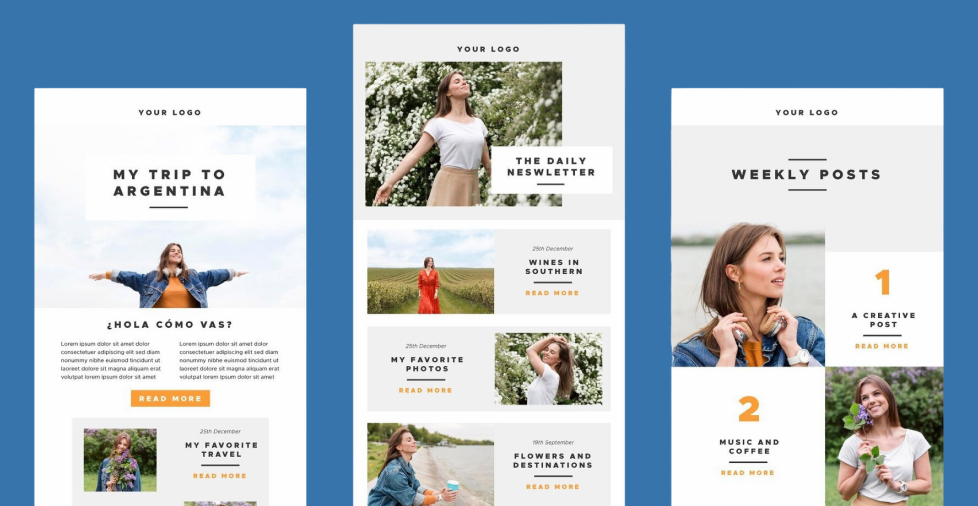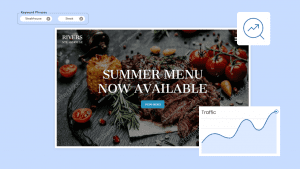Key takeaways:
- A newsletter works best when you understand your audience, set clear goals, and choose the right email service provider.
- Simple, consistent design combined with compelling subject lines and valuable content strengthens your email marketing strategy over time.
- The right email marketing software streamlines newsletter creation, while avoiding cluttered layouts, and keyword stuffing to keep readers engaged.
Ever feel like your social posts just disappear into the feed? It’s tough to cut through the noise when algorithms decide who sees your content. That makes it harder to build a steady connection with the people who want to hear from you.
And if you’re only relying on social media, you don’t really own that audience. One platform change or drop in reach can mean fewer clicks, fewer sales, and less engagement overnight.
With a newsletter, you get a direct and reliable line to your audience with no middleman. In this guide, we’ll show you exactly how to create one from scratch, step by step, so you can start sharing updates, building trust, and growing your business on your own terms.
What is a newsletter?
A newsletter is a recurring email sent to subscribers who’ve chosen to hear from you. Its main purpose is to share information or resources that keep your audience engaged and connected to your brand.
Think of it as your own digital magazine but tailored specifically to the people who care about what you do.
There are different types of newsletters, each serving a unique purpose:
- Digest newsletters. Roundups of articles, blog posts, or industry news.
- Promotional newsletters. Highlight sales, special offers, or product launches.
- Educational newsletters. Provide tips, tutorials, or insights that add value.
- Product update newsletters. Share new features, releases, or improvements.
The type you choose depends on your goals. Some businesses stick to one format, while others mix and match depending on what their audience responds to.
Why newsletters matter for businesses
A newsletter gives you something social media can’t: a direct line to your audience that you own. Every email goes straight to someone who chose to hear from you, making it one of the most reliable marketing channels out there.
Here’s what makes newsletters so valuable:
- Create a channel you control without relying on algorithms.
- Build trust and loyalty by showing up consistently.
- Drive engagement and conversions through promotions, product launches, or helpful resources.
- Scale easily, whether you’re a local shop, solo creator, or growing brand.
Newsletters are really about building relationships. You’re talking directly to people who already want to hear from you, and that personal connection makes every message more meaningful and impactful.
How AI is reshaping newsletters
AI is changing the way marketers create and share newsletters. From drafting copy in minutes to making sure your newsletter shows up in AI-powered search results, these tools can make your campaigns faster, smarter, and more creative.
AI for faster creation and efficiency
Modern AI tools can take the heavy lifting out of routine tasks:
- Content brainstorming. Generate subject line ideas, content topics, or even draft email copy in seconds.
- Design help. Tools can suggest layouts, check accessibility (contrast, alt text), and optimize for mobile automatically.
- Automation. AI can recommend send times, suggest audience segments, or help schedule campaigns for maximum engagement.
By automating repetitive steps, you free up time to focus on strategy and personal touches that matter.
AI search and newsletter discoverability
With AI-driven search tools like Google’s Search Generative Experience (SGE) or Perplexity AI, parts of your newsletter can surface directly in search results. This means your email content could reach people even before they subscribe.
To make your newsletters more discoverable:
- Use clear headlines and summaries that AI can easily read.
- Structure sections in FAQ or Q&A style for better indexing.
- Keep the language natural and conversational.
- Add schema or structured snippets if your platform allows.
This blend of creation and discoverability is what makes AI such a game-changer. It’s not only helping you work faster but also helps your work reach the right audience in more ways than ever before.
How to create a newsletter: A step-by-step guide
Creating a newsletter can feel overwhelming if you’ve never done it before. The good news is, it’s easier than it looks when you break it into clear steps. Here’s how to get started:
- Plan your content strategy
- Build and segment your email list
- Design your newsletter
- Write your subject line and copy
- Test and preview before sending
- Send and analyze results
Step 1. Plan your content strategy
A great newsletter starts with a clear plan. The first step is to define who you’re writing for and what you want to achieve. Knowing your audience and goals sets the direction for everything else, from the design to the content.
- Pick 2–3 themes your audience cares about (tips, updates, offers).
- Choose a frequency you can actually stick to like weekly, every two weeks, or monthly.
- Set one clear goal for each issue, like driving traffic to a blog post or promoting a sale.
For example, a fitness coach might share weekly workout tips, while an online shop could use a newsletter to promote product launches or discounts. Once you’ve identified your readers, decide what success looks means for you, whether that’s driving more traffic, boosting sales, or building stronger customer relationships.
With that foundation, you can map out your content themes and frequency. Stick to two or three themes that matter most to your audience (like tips, updates, or offers), and pick a realistic schedule like weekly, bi-weekly, or monthly.
If you want to learn more about content marketing, you can check out our guide to content marketing for small business.
Step 2. Build and segment your email list
Your newsletter is only as strong as the people on your list. Focus on growing a clean, engaged subscriber base.
- Add signup forms to your website, blog, or checkout page.
- Offer an incentive, like a discount or free guide.
- Use double opt-in to confirm subscribers (this helps keep your list clean).
- Segment your list, like new subscribers vs. loyal customers so you can send each group content they’ll find useful.
Always send a welcome email to set the tone and let people know what to expect.
Step 3. Design your newsletter
Design can make or break your newsletter. A good design makes it easy to read and encourages people to click through, while a messy one can turn readers away. The key is to keep things clean, consistent, and mobile-friendly.
- Choose a simple template with your branding.
- Structure content so it’s scannable: headline → short description → call to action.
- Keep fonts and colors consistent.
- Optimize for mobile with clear buttons and responsive layouts.
Quick accessibility checklist:
- Add alt text to all images.
- Make sure text and background colors have enough contrast.
- Keep paragraphs short for easy reading.
- Test on a phone to be sure it looks good on small screens.
Step 4. Write your subject line and copy
Even the best content won’t matter if nobody opens your email. Your subject line is the first thing people see, and it often decides whether they’ll click or ignore. Once inside, your copy should feel like a friendly conversation that leads readers to take action.
- Keep it short (40–60 characters).
- Highlight the benefit, like “3 Tips for Saving Time This Week.”
- Use a preheader (the text preview under the subject line) to add extra detail.
- Personalize when it makes sense, but don’t overdo it.
- Try using AI tools to brainstorm ideas, then edit them so they sound natural.
Inside the email, keep the tone conversational, with one main point and a clear CTA (call-to-action).
If you want more inspiration on writing subject lines, check out our full guide to the best email subject lines.
Step 5. Test and preview before sending
It’s normal to run into mistakes, like broken links, images that don’t load, or subject lines that don’t land. That’s why testing is critical. A quick check before you send your newsletter can save you from embarrassing errors and keep everything looking professional.
- Preview your newsletter on desktop and mobile.
- Click every link to make sure it works.
- Check that images load and alt text shows up.
- Send a test email to yourself or a teammate.
- Run A/B tests on subject lines or CTAs to see what performs better.
Step 6. Send and analyze results
Hitting “Send” is just the beginning. The real value of newsletters comes from what you learn after each campaign. Tracking results helps you understand what your audience enjoys, so you can improve over time and grow your impact.
- Start with basic metrics: open rates, click-through rates, and unsubscribes.
- Track what type of content performs best.
- Use these insights to improve the next issue.
The goal is progress, not perfection. Each send teaches you what your audience likes (and doesn’t).
Complying with privacy regulations and email best practices
Before you hit send on your first newsletter, it’s important to make sure you’re following email privacy rules. These rules help build trust with your audience by showing that you respect their data and preferences.
Why compliance matters
Ignoring email laws can result in fines, blacklisting, or losing the trust of your subscribers. Following the rules, on the other hand, reassures readers that their inbox is safe with you—which makes them more likely to stick around.
The main regulations to keep in mind include:
- GDPR (Europe). Requires clear consent and easy opt-out options.
- CAN-SPAM (US). Mandates accurate sender info and unsubscribe links.
- CASL (Canada). Focuses on express consent and record-keeping.
Even if your business is small, these rules can apply if you’re emailing people in those regions.
To stay compliant and build trust, make it a habit to:
- Use double opt-in to confirm subscribers actually want your emails.
- Always include a visible unsubscribe link in every message.
- Keep your privacy policy transparent and easy to find.
- Don’t buy email lists. Focus on growing your own.
When you build compliance into your process, you not only avoid penalties but also create a newsletter that feels safe, reliable, and worth opening.
Tools to help you create newsletters
The right tools can make building and sending a newsletter much easier. From drag-and-drop design to analytics dashboards, modern platforms take care of the heavy lifting so you can focus on the content.
Free vs. paid platforms
Most platforms offer free starter plans and paid upgrades. Free plans are great for beginners, while paid options unlock advanced features, like automations and detailed reports.
| Platform | Best for | Free plan | Key features |
| Mailchimp | Small businesses | Yes | Templates, automations, analytics |
| Brevo | SMBs and marketers | Yes | Email + SMS, segmentation tools |
| ConvertKit | Creators and bloggers | Yes | Subscriber tagging, automations |
| Substack | Writers and publishers | Yes | Paid subscriptions, simple editor |
| Constant Contact | Growing businesses | No | Customer support, list management |
| HubSpot Marketing | Teams using HubSpot CRM | Limited | CRM integration, advanced analytics |
Mistakes to avoid when starting a newsletter
When you’re just getting started, it’s easy to run into common pitfalls that can hold your newsletter back. The biggest issues usually come down to design, targeting, and how you write your content. Here’s what to watch out for:
Overloading design
A cluttered design makes newsletters hard to read and even harder to enjoy. Too many colors, fonts, or sections can overwhelm readers and push them to click away. Keep your layout clean, consistent, and mobile-friendly so the focus stays on your message.
Ignoring segmentation
Sending the same email to everyone on your list may seem easier, but it usually leads to low engagement and higher unsubscribe rates. Different groups of subscribers have different needs, so segmenting your list even into simple categories like new vs. loyal customers, helps your emails stay relevant.
Keyword stuffing or ignoring AI phrasing
Forcing too many keywords into your copy makes your email sound robotic. Meanwhile, ignoring how people and AI search tools process text can hurt visibility. Aim for a natural, conversational tone, using keywords only where they fit. Formatting content with clear headings or Q&A-style sections can also make your newsletter easier to scan and more discoverable.
Workflow and templates
Once you understand the basics, the next step is building a workflow you can repeat and refine. A solid process makes newsletters less overwhelming and helps you stay consistent. Templates can also save time, giving you a ready-made starting point for different types of emails.
Beginner workflow
If you’re new to newsletters, keep it simple. A straightforward process helps you focus on the essentials.
- Plan your content and goals.
- Build and grow your email list.
- Design a clean, mobile-friendly template.
- Send your newsletter and track results.
AI-powered workflow example
AI tools can speed up planning and content creation without taking away the personal touch.
- Use AI to brainstorm newsletter topics or subject line ideas.
- Generate draft copy, then edit to match your brand voice.
- Let AI help optimize send times or segment recommendations.
- Automate parts of your workflow so you can focus on strategy.
Template library
Templates take the guesswork out of formatting and structure. Many email platforms offer ready-to-use options for:
- Welcome emails to greet new subscribers.
- Digest-style newsletters that round up content or resources.
- Promotional campaigns highlighting special offers.
- Product updates with new features or launches.
Need help designing CTAs that boost engagement? Check out our blog on how to write a call to action. It covers placement, clarity, and testing tips to help your newsletter drive action.
Get started with your first newsletter
Starting a newsletter doesn’t have to be complicated. Once you break it into clear steps like planning, writing, testing, and analyzing, it becomes a repeatable process you can refine over time. The key is to start small: pick one platform, focus on one audience group, and send your first edition.
When you’re ready to send your first newsletter, make sure it comes from a professional email address that matches your brand. A professional address creates a strong first impression and builds credibility with your audience. With Network Solutions, you can send your first newsletter confidently and start your email strategy on the right foot.
Frequently asked questions
The best option depends on your needs. Popular email marketing software like Mailchimp, Brevo, or Constant Contact offer templates, analytics, and a drag and drop editor. Most let you start with a free account, then upgrade as your email marketing strategy grows.
Yes, Word has simple templates, but they’re better for print. For email campaigns, use an email service provider so your design works across email clients and mobile devices, and you can track results.
Keep your design clean, use consistent fonts, make content scannable, add white space, include clear calls-to-action, and test on mobile devices. Pair this with a compelling subject line to encourage readers to open and click.
Google doesn’t offer a full newsletter tool. You can design in Docs or Slides, but sending campaigns requires an email service provider like Brevo or Mailchimp. Gmail can send group emails, but it’s not built for email marketing strategy or tracking.




